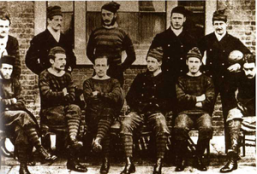The World's Game

British Army Engineers football team, 1870
The game of football first started to arise and take shape in England in the latter part of the 19th century. With the onset of the Industrial Revolution, Englishmen were drawn in great numbers into rapidly developing cities, depriving them of their traditional methods of outdoor leisure and recreation in the country. As a result, new sports began to arise which enshrined age-old English values of hard work and competition, but which also could be adapted to accommodate the demands of a dynamic, modern society. Chief among these new sports were rugby, cricket, and of course, football.
Football as we know it today initially arose as a variation of the game of rugby, which also came to prominence in the early 19th century. As such, in the very beginning football lacked an agreed-upon structure or uniform set of rules. It was primarily played at various clubs and schools across England, with each practicing their own variation of the game. This all changed in 1863, when the chief schools and clubs gathered together to form The Football Association (1) . In addition to setting up the FA, which remains football's governing body in England to this day, the representatives agreed to adopt 14 Laws of the Game. These laws, which have remained relatively unchanged even into the present day, would serve as the foundation upon which the newly codified game of football would flourish.
From England, football quickly spread to every corner of the British Isles and across the English Channel to continental Europe as well. The first international match took place between England and Scotland in 1870 (1) . By 1896, clubs or football associations had been established in Scotland, Wales, Ireland, Germany, France, the Netherlands, Belgium, Denmark, Portugal, and Switzerland (2) . 1904 saw the establishment of La Fédération Internationale de Football Association, better known in the English-speaking world by its acronym, FIFA. From Europe, football began to expand outward into the remaining corners of the world. European traders, workers, and soldiers brought the game to their colonies in Africa, Asia, and Latin America. British railway workers introduced football to Argentina in 1867 and to Brazil in 1887. Similar experiences led to the formation of football associations in British and French colonies in Africa, in Indochina, in Australia, and on the Indian subcontinent. The following table illustrates the rapid growth of football around the world, as evidenced by the increasing number of national football associations constituting FIFA (3) .
Year Number of FIFA Members | Year Number of FIFA Members
1904 7 1954 85
1914 24 1959 95
1923 31 1984 150
1930 41 1991 165
1938 51 1994 190
1950 73 2010 208
Today, the game continues to grow and attract new players and fans in all parts of the world. FIFA currently comprises 208 national football associations. That is 16 more than the number of member states of the United Nations. Truly, this has become the world's game.
To Learn More About the History of Football/Soccer
FIFA.com's History of Soccer
All-Soccer-Info.com
wsoccer.com
(1) "History of the FA." http://www.thefa.com/TheFA/WhoWeAre/HistoryOfTheFA. 2010.
(2) Eric Dunning. "The Development of Soccer as a World Game." Sport Matters: Sociological Studies of Sport, Violence, and Civilization. Taylor & Francis, 1999. Pg. 103.
(3) http://www.fifa.com/index.html
Football as we know it today initially arose as a variation of the game of rugby, which also came to prominence in the early 19th century. As such, in the very beginning football lacked an agreed-upon structure or uniform set of rules. It was primarily played at various clubs and schools across England, with each practicing their own variation of the game. This all changed in 1863, when the chief schools and clubs gathered together to form The Football Association (1) . In addition to setting up the FA, which remains football's governing body in England to this day, the representatives agreed to adopt 14 Laws of the Game. These laws, which have remained relatively unchanged even into the present day, would serve as the foundation upon which the newly codified game of football would flourish.
From England, football quickly spread to every corner of the British Isles and across the English Channel to continental Europe as well. The first international match took place between England and Scotland in 1870 (1) . By 1896, clubs or football associations had been established in Scotland, Wales, Ireland, Germany, France, the Netherlands, Belgium, Denmark, Portugal, and Switzerland (2) . 1904 saw the establishment of La Fédération Internationale de Football Association, better known in the English-speaking world by its acronym, FIFA. From Europe, football began to expand outward into the remaining corners of the world. European traders, workers, and soldiers brought the game to their colonies in Africa, Asia, and Latin America. British railway workers introduced football to Argentina in 1867 and to Brazil in 1887. Similar experiences led to the formation of football associations in British and French colonies in Africa, in Indochina, in Australia, and on the Indian subcontinent. The following table illustrates the rapid growth of football around the world, as evidenced by the increasing number of national football associations constituting FIFA (3) .
Year Number of FIFA Members | Year Number of FIFA Members
1904 7 1954 85
1914 24 1959 95
1923 31 1984 150
1930 41 1991 165
1938 51 1994 190
1950 73 2010 208
Today, the game continues to grow and attract new players and fans in all parts of the world. FIFA currently comprises 208 national football associations. That is 16 more than the number of member states of the United Nations. Truly, this has become the world's game.
To Learn More About the History of Football/Soccer
FIFA.com's History of Soccer
All-Soccer-Info.com
wsoccer.com
(1) "History of the FA." http://www.thefa.com/TheFA/WhoWeAre/HistoryOfTheFA. 2010.
(2) Eric Dunning. "The Development of Soccer as a World Game." Sport Matters: Sociological Studies of Sport, Violence, and Civilization. Taylor & Francis, 1999. Pg. 103.
(3) http://www.fifa.com/index.html
